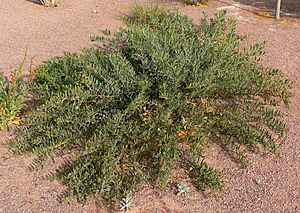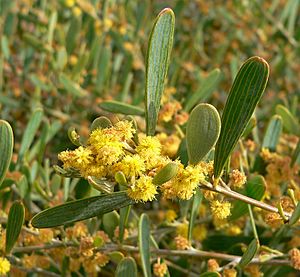Bank catclaw facts for kids
Quick facts for kids Bank catclaw |
|
|---|---|
 |
|
| Scientific classification | |
| Genus: |
Acacia
|
| Species: |
redolens
|
 |
|
| Occurrence data from AVH | |
Acacia redolens, often called bank catclaw, prostate acacia, or desert carpet, is a type of shrub. It belongs to the Acacia plant family. This plant is known for its strong vanilla scent.
Description
This plant is a bushy shrub. It usually grows to be about 0.5 to 3 metres (2 to 10 ft) tall. Sometimes, it can even reach up to 7 meters (23 feet). The plant parts, especially its yellow flowers, smell strongly of vanilla.
The small yellow flowers bloom from August to October in its native home. In California, they bloom from February to May. The flowers get their bright yellow look from their many stamens (the parts that make pollen). The flowers grow where the leaves meet the stem, called the leaf axil. After blooming, the plant makes brownish legumes (seed pods). These pods are about 25 millimeters (1 inch) long and 6 millimeters (0.2 inches) wide.
In California, Acacia redolens is often planted along freeways. You can find it across Southern California and in some parts of the Bay Area.
Where It Grows
This plant naturally grows along the southern coast of Western Australia. It is found in the Great Southern and Goldfields-Esperance areas.
However, in parts of California, Acacia redolens is considered an unwanted plant. It was planted there to cover the ground quickly along freeways. Now, it spreads easily and can cause problems for local plants. It is especially common in the San Gabriel Valley and Mission Valley.
Acacia redolens grows well in salty or alkaline soils. These soils can be loamy, clayey, or sandy. It is often found near salt lakes or in salty dips in the ground. This plant can also handle cold weather, surviving frosts down to about -7°C (19°F).


